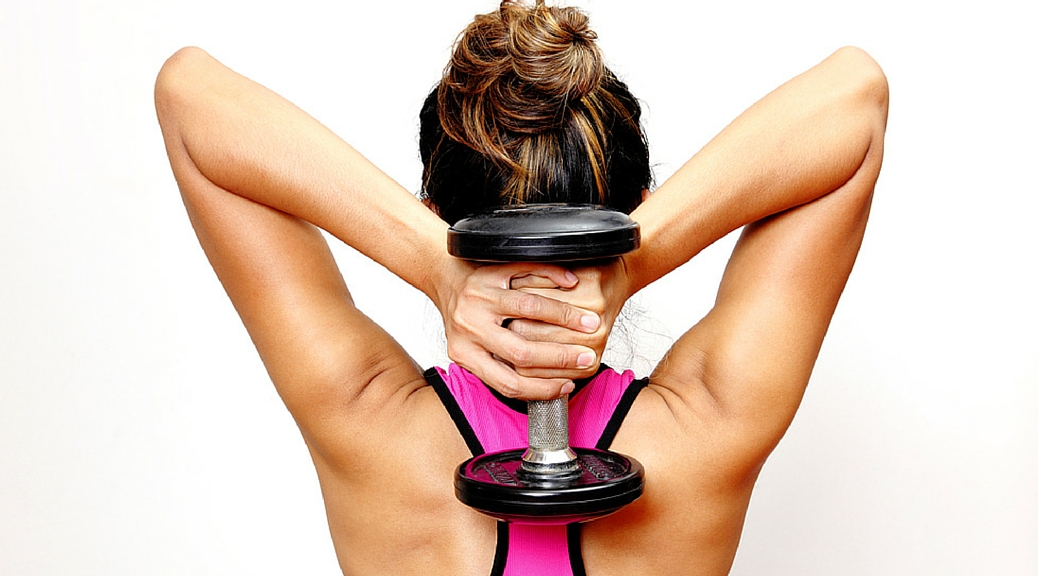There’s this belief that if women lift weights, they’re going to become too muscular. This is far from the truth! Lifting weights helps women burn fat, lose pounds, and tone muscles. Sure, if you lift heavy enough, you will gain muscle. However, that takes a long time and some heavy weights! Weight-lifting is very good for women, especially with the right weights!
It helps tone your muscles; the more active your muscles are, the more calories you burn when you’re not in the gym. So how do you know which size of weights is right for you? We came across an article from our favorite SELF Magazine that helps you answer that question, and we’re sharing with the CGS Community! Personal Trainer Cori Lefkowith gives a few rules to follow the next time you go to pick up some weights!
“Although there’s no exact weight range for every person, there are some general rules you can follow to make sure your weight isn’t too light or too heavy, but just right. Here’s what you need to know about choosing the correct weights for your strength workout.
1. Your weight should make you work for those last few reps (without compromising your form).
Think of this as a fitness experiment—it may take a few sets to find your sweet spot, but then you’ll know what pair of weights to pick up next time. “You know the weight is heavy enough if you struggle to complete the last few reps and would have liked to end a few reps before you planned to,” says Lefkowith. So, if you planned on doing 12 reps, you should want to give it a rest around the eighth rep, says Lefkowith. You should be able to keep the correct form right up until your last rep (but not much longer).
“A weight is too heavy if you struggle to maintain proper form or can’t hit the number of repetitions set out in the workout,” says Lefkowith. With a weight that’s too heavy, you risk injuring yourself or unintentionally using muscles you don’t mean to work to compensate. For example, using momentum or your back muscles to bring the weight up during a bicep curl instead of, well, your biceps.
2. But your weight is too light if you don’t start to struggle during those last few reps.
“A weight is too light if you easily cruise through the all of your reps—and could even do extra,” says Lefkowith. “Though you may feel things working and even feel a ‘burn,’ that doesn’t mean the weight is challenging.” You should start to feel the work from the very first rep, she adds—if you feel like you’ll have no problem getting to the end, it’s too light.
3. The exercise you’re doing can help determine what weight you use.
The weight you use should correspond to the strength of the muscles you’re working. For example, your glutes are very powerful, explains Lefkowith, so you can probably go pretty heavy with a weighted squat or deadlift. “However, if you are working the back of your shoulders with a posterior fly, you may need to go lighter because it is a smaller, weaker muscle group,” says Lefkowith. “Consider the muscle group that you’re working and make sure you choose a weight that challenges the muscles without compromising form.” Sense a theme here? Form above everything!
4. And the type of weight you use matters, too.
There are many different types of weights you can use in a strength workout (including dumbbells, barbells, sandbags, and kettlebells), and that may determine how heavy you go for any given exercise.
“You may find you need to go lighter with more functional, unstable weights,” says Lefkowith. Unstable weights refer to how the weight is distributed in the equipment. So, while your dumbbell is evenly loaded on both sides, making for a stable and symmetrical piece of equipment, the sand in a sandbag will shift as you move it around. That will cause your muscles to work a little harder to make sure you stay balanced.
“While you may be able to lift a 20-pound dumbbell, you may find a 10-pound sandbag challenging for the same move. The instability of the functional weight may make the weight more challenging, even if it isn’t as heavy as the other tool.”
5. Ultimately, it all comes down to listening to your body (and some trial-and-error, too).
Whether you go for five-pound weights or 50, it all depends on your level of experience—if you’re just starting out, it’s a good idea not to increase your weight too fast so you can make sure you’re nailing the correct form, says Lefkowith.
If you’re feeling ready to take it to the next level, go ahead and challenge yourself with heavier weights. Feeling sore and tired? There’s also nothing wrong with scaling back the weight every once in a while. You might have to pick up a few different weights to find the right fit for any given day, but it’s worth a little trial-and-error to learn what works for you and get the results you want.
“And remember, ‘heavy’ or ‘light’ means heavy or light to you,” adds Lefkowith. “It isn’t based on what your friend uses or someone on social media. If you want results, you’ve got to focus on what you need to use to challenge yourself. Don’t worry about what someone else is lifting!”
As seen on Here’s How To Choose The Right Weights When Strength Training by SELF Magazine.
Remember these rules when it comes to lifting weights! Don’t be afraid to get a little tone in either. Do incorporate weight-lifting in your workout routine? How do you determine which weights to lift for your body? Do you have any tips to share? Post a comment below to share your thoughts and give some tips!






1 thought on “Choosing the Right Weights at the Gym”
I always toggle between 5lbs and 8lbs when weight-lifting. I find that I do struggle after the 2nd set, however I think I should be lifting heavier 🙁